Quantized hydrodynamics on the sphere


Klas Modin
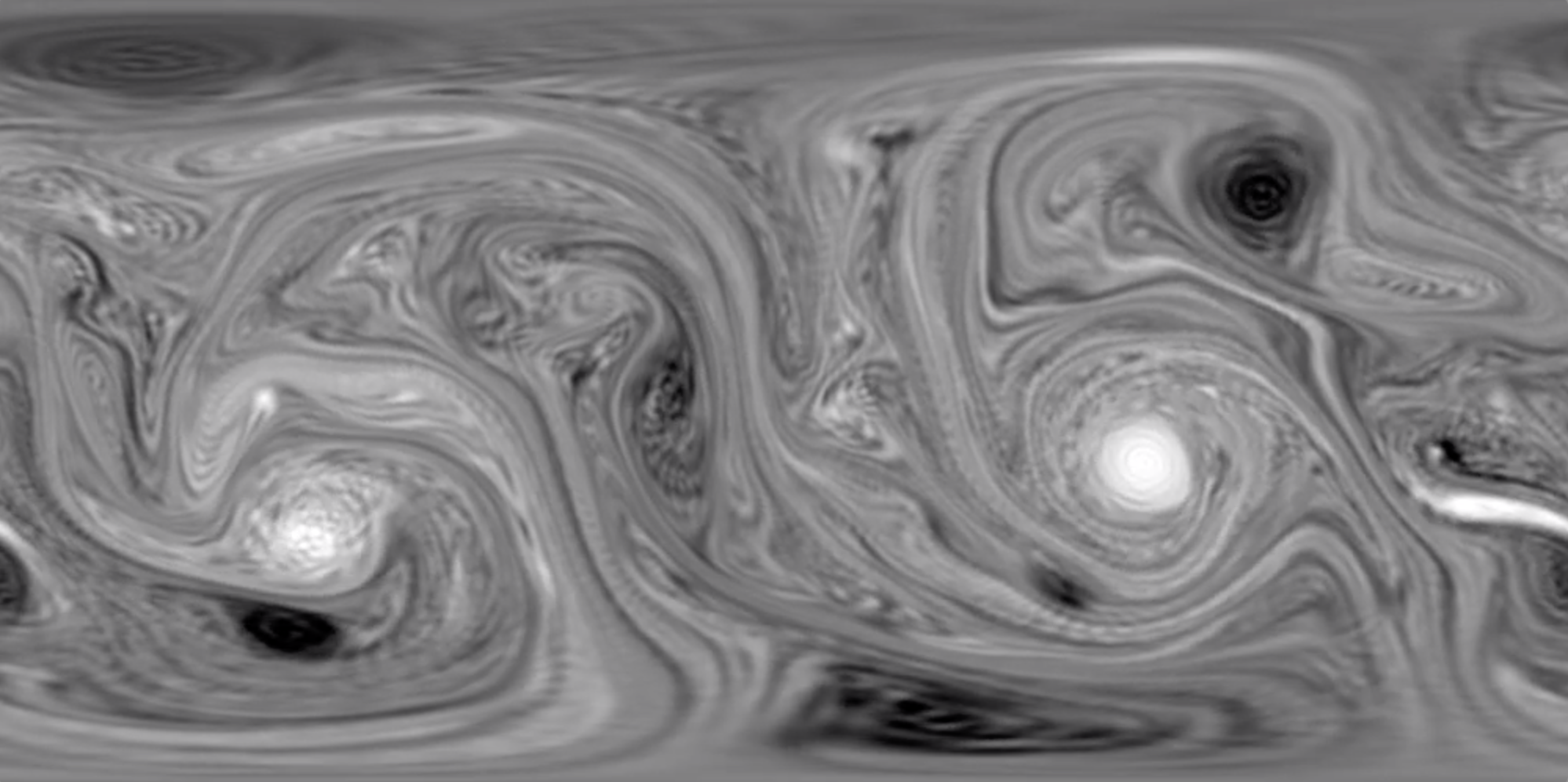

azimuth
2D Euler on the Sphere
elevation
Can statistical mechanics be used to explain clustering?
Idea by Onsager (1949):
- Approximate \(\omega\) by PV for large \(N\)
- Find invariant measure and presume ergodicity
Hamiltonian function:
Onsager's observation:
Pos. and neg. strengths \(\Rightarrow\) energy takes values \(-\infty\) to \(\infty\)
\(\Rightarrow\) phase volume function \(V(E)\) has inflection point

Idea by Onsager (1949):
- Approximate \(\omega\) by PV for large \(N\)
- Find invariant measure and presume ergodicity
Hamiltonian function:


Can statistical mechanics be used to explain clustering?
Onsager's theory has problems
Quantization yields Lie-Poisson preserving discretizations
Zeitlin (1991)
Classical
Quantized
Zeitlin's equations
vorticity matrix
stream matrix
Hoppe-Yau Laplacian
Lost in translation: dictionary hydrodynamics \(\leftrightarrow\) quantum physics
| Classical | Quantum | |
|---|---|---|
| Lie group | ||
| Lie algebra | ||
| Phase space | ||
| "Strong" norm | ||
| Enstrophy norm | ||
| Energy norm | ||
| Measurables | ||
| Singular sol. | vortex sheets | rank-1 matrices |
| Axi-symmetry |
\(\operatorname{SDiff}(\mathbb{S}^2)\)
\(\operatorname{SU}(N)\)
\(\mathfrak{X}_\mu(\mathbb{S}^2)\)
\(C^\infty_0(\mathbb{S}^2)\)
\(\mathfrak{su}(N)\)
\(\mathfrak{su}(N)^*\simeq \mathfrak{su}(N)\)
\(\lVert \cdot\rVert_{L^\infty}\)
spectral norm
\(\lVert \cdot\rVert_{L^2}\)
Frobenius norm
\(\lVert \cdot\rVert_{H^{-1}}\)
\(\operatorname{tr}(PW)^{1/2}\)
values of \(\omega\)
eigenvalues of \(W\)
\(\omega\) zonal
\(W\) diagonal
azimuth
elevation
Long-time dynamics look like
"blob"-vortex dynamics
positive blobs
negative blobs
Are there low dim, near integrable stable invariant manifolds?
- Small vorticity formations merge to larger
- Well-separated blobs interact by blob-vortex dynamics (BVD)
- Dynamics is not integrable \(\Rightarrow\) blobs continue to merge
- \(k\)-BVD integrable \(\Rightarrow\) quasi-periodicity prevents further mixing
Shnirelman (2005)
Question 1: How can merging occur when vorticity is transported?
- Arnold (1966): \(\omega(t) = \varphi^t_*\omega(0) \) for \(\varphi^t\in\operatorname{SDiff}(\mathbb{S}^2)\)
- Izosimov, Khesin, Mousavi (2016): Orbits of simple Morse functions = Reeb graphs
Euler's equations (2D):
Zeitlin's equations:
- \(W(t) = E(t)W(0) E(t)^\dagger \) for \(E(t) \in SU(N) \)
- Spectral theorem: orbits = diagonal matrices with increasing eigenvalues
- Diagonal = zonal \(\rightarrow\) possible to destroy critical points \(\rightarrow\) merging possible (but "hard")
Zeitlin's equations describe generalized hydrodynamics
Shnirelman (1993)
Bordemann, Meinrenken, Schlichenmaier (1994)
\(W \to \omega\) in weak* sense as \(N\to \infty\)
Question 2: Is blob vortex
dynamics integrable?
Dirac \(\delta_x\)
axisymmetric blob \(b_x\) centered at \(x\)
Same \(SO(3)\) symmetry!
Known about integrability
Point vortex dynamics on \(\mathbb{S}^2\)
- 3-PVD is integrable (Sakajo, 1999)
- 4-PVD is integrable for vanishing momentum (Sakajo, 2007)
- 4-PVD non-integrable in general (Bagrets & Bagrets, 1997)
Symplectic reduction theory:
only \(SO(3)\) symmetry needed in proof
Blob vortex dynamics on \(\mathbb{S}^2\)
- 3-BVD is integrable
- 4-BVD is integrable for vanishing momentum
Proposed mechanism under scrutiny
Non-zero angular momentum
passed 1st test!
Question 3: Are BVD solutions stable within Euler flow?
- Clearly BV profiles change dynamically
- Initially small perturbation
- Remains small?
?
- Strategy: study dynamics on \( (\mathfrak{su}(2)\times \mathfrak{su}(N))^k\)
small w.r.t.
\(H^{-1}\) or \(L^2\)
or what?
Question 4: Is there a natural way to separate scales?
Underlying notion: quantization yields canonical vorticity splitting
- Linear subspace \(\operatorname{stab}_P = \operatorname{ker}[P,\cdot]\subset \mathfrak{su}(N)\)
- Project \(\Pi_P:W\mapsto W_s\in\operatorname{stab}_P\)
- Gives canonical splitting \( W = W_s + W_r\)
Evolution of canonical components

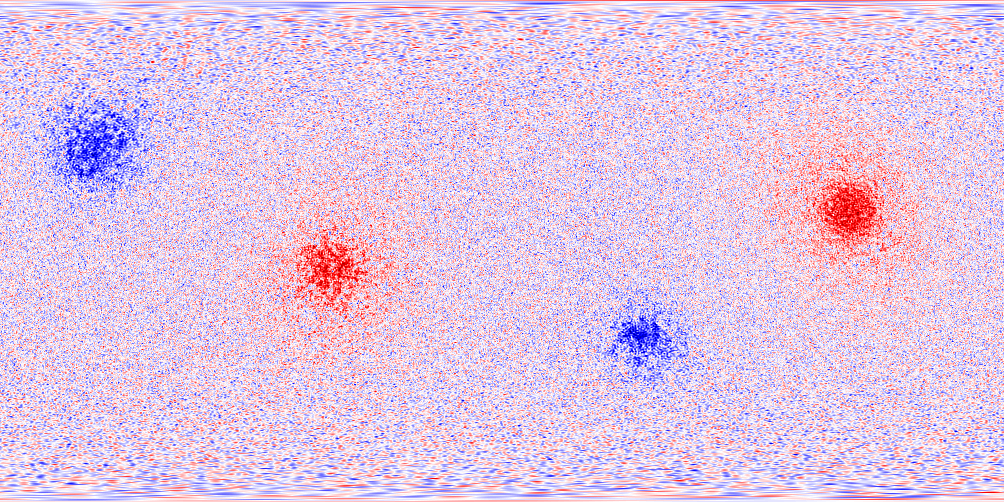

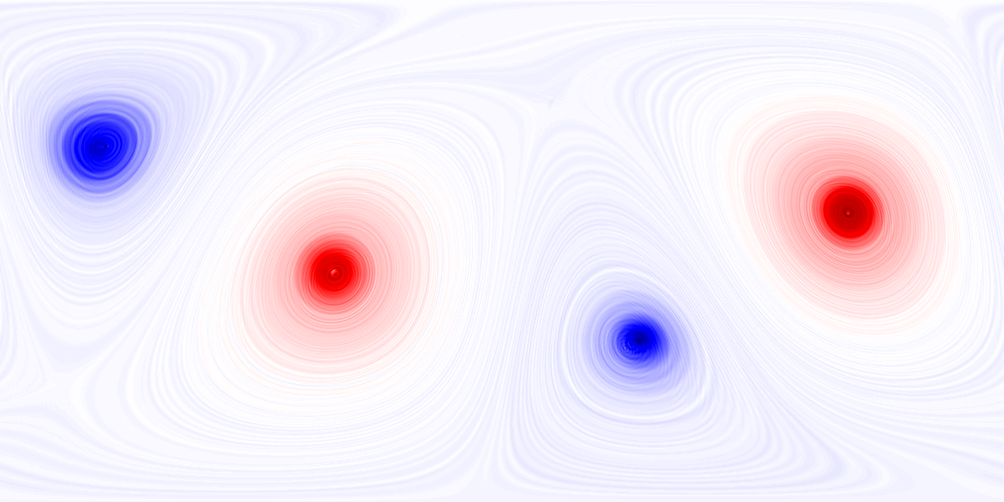
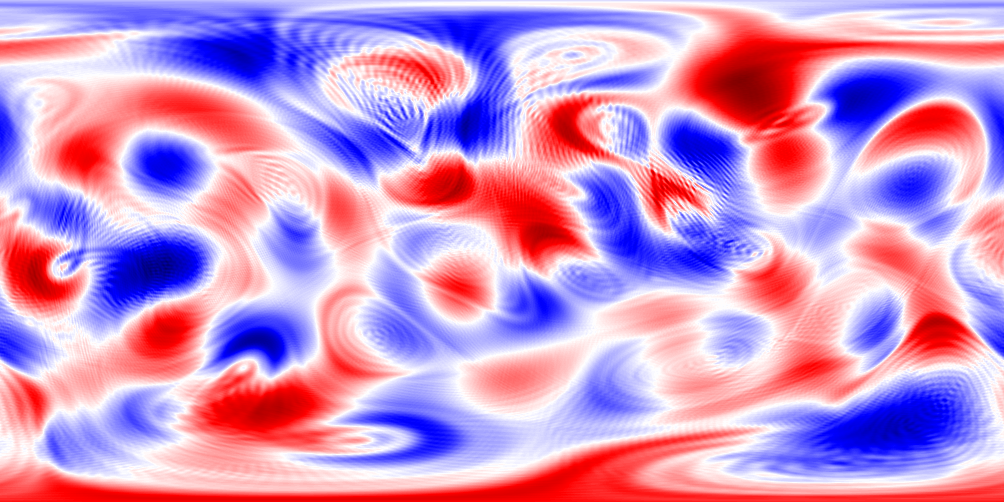
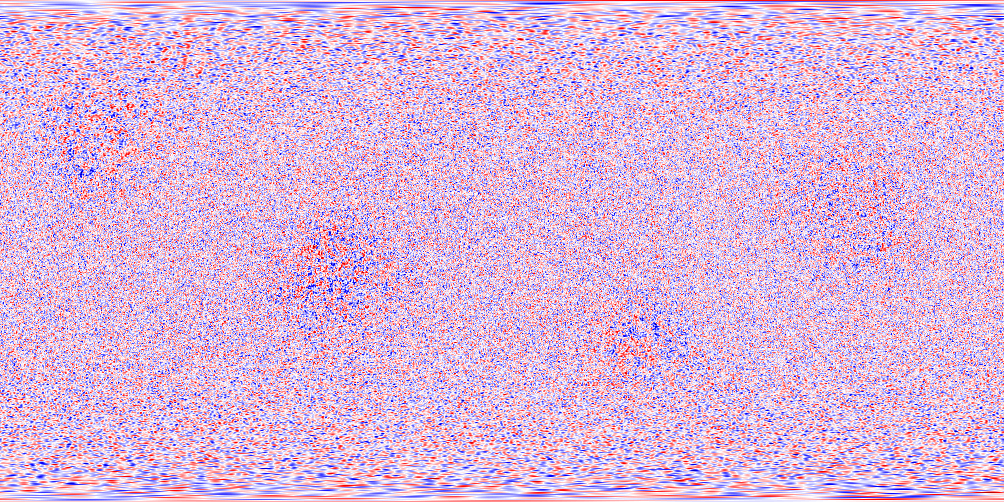
Enstrophy for canonical components

Enstrophies:
\(E = \langle W,W\rangle_F\) \(E_s = \langle W_s,W_s\rangle_F\) \(E_r = \langle W_r,W_r\rangle_F\)
Energy for canonical components
Energies:
\(H = \langle W,\Delta_N^{-1}W\rangle_F\) \(H_s = \langle W_s,\Delta_N^{-1}W_s\rangle_F\) \(H_r = \langle W_r,\Delta_N^{-1}W_r\rangle_F\)

Geometry of enstrophy and energy
\(W_r \bot W_s\) in enstrophy norm
\(W_r \bot W\) in energy norm
enstrophy levelset of \(W\)
energy levelset of \(W\)
Equivalence of norms:
We expect Zeitlin's
model to be "grainy"
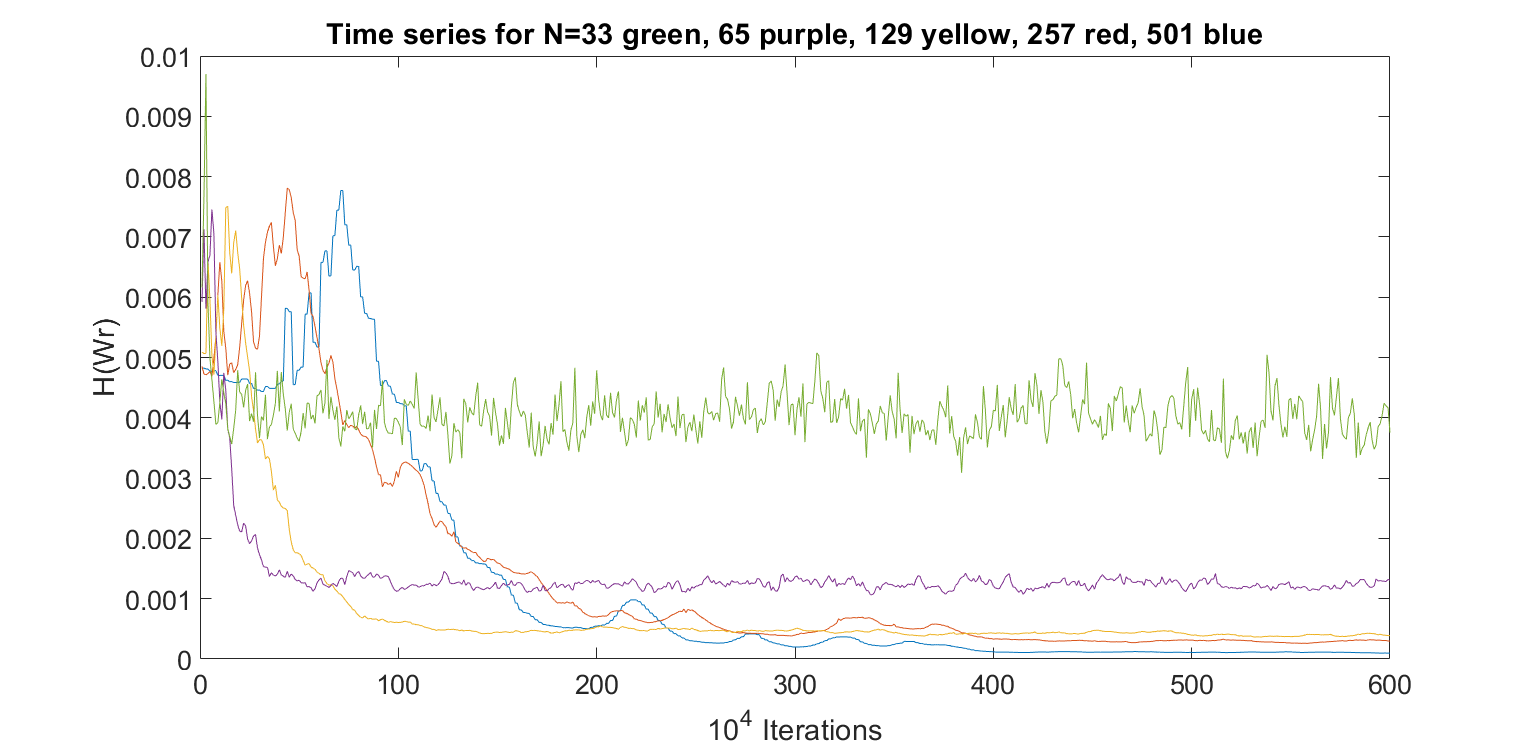
Canonical components capture "broken line" energy spectrum
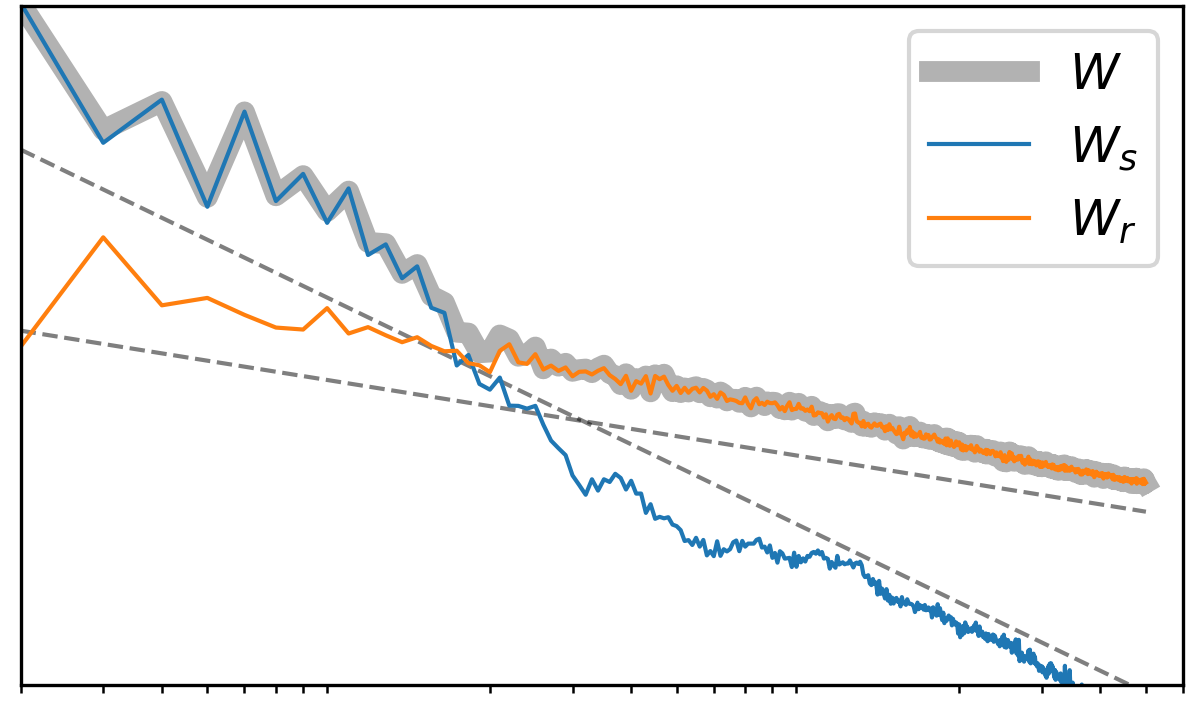
Summary: Zeitlin's model might yield useful insights on long-time dynamics for 2D Euler
References:
- M. & Viviani (2021)
Canonical scale separation in two-dimensional incompressible hydrodynamics - M. & Viviani (2021)
Integrability of point-vortex dynamics via symplectic reduction: a survey - M. & Viviani (2020)
A Casimir preserving scheme for long-time simulation of spherical ideal hydrodynamics - M. & Viviani (2020)
Lie-Poisson methods for isospectral flows
Slides available at: slides.com/kmodin